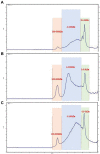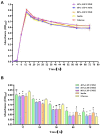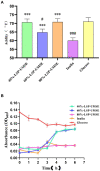Composition analysis and prebiotics properties of polysaccharides extracted from Lepista sordida submerged cultivation mycelium
- PMID: 36713178
- PMCID: PMC9879602
- DOI: 10.3389/fmicb.2022.1077322
Composition analysis and prebiotics properties of polysaccharides extracted from Lepista sordida submerged cultivation mycelium
Abstract
In this paper, Lepista sordida polysaccharides (LSP) were separated from Lepista sordida (L. sordida) mainly using the Ultrasonic-Micro Wave Synergy Extraction (UMSE) method and purified by graded alcohol precipitation. Three polysaccharide components: 40%-LSP-UMSE, 60%-LSP-UMSE, and 80%-LSP-UMSE were obtained and further analyzed the physicochemical properties, structural characteristics, and antioxidant activity. And the effects on the proliferation of Lactobacillus casei of three polysaccharide components were studied. The characteristic absorption peaks and the β-glycosidic bond of three polysaccharide components were the direct expression at UV 200 nm using UV and FT-IR spectroscopy. The three polysaccharide components were mainly composed of glucose, mannose, galactose, and ribose using high-performance liquid chromatography (HPLC) analysis. The antioxidant activity study revealed that the polysaccharides obtained by the UMSE method had better antioxidant activity compared to the traditional "Hot Water Extraction (HWE)" method. In addition, the polysaccharide components promoted the proliferation of L. casei to some extent. 40%-LSP-UMSE, 80%-LSP-UMSE as the carbon source had better acid production than the control inulin. Three LSP-UMSE used as a carbon source compared with glucose for culturing L. casei could significantly improve its tolerance to bile salts. Results are helpful to develop the bioactive polysaccharides from Lepista sordida and beneficial to develop a unique health and functional product in the future.
Keywords: Lepista sordida polysaccharides; antioxidant; monosaccharide composition; prebiotics; ultrasonic-micro wave synergy extraction method.
Copyright © 2023 Wang, Lian, Zheng, Wang, Wang and Yang.
Conflict of interest statement
The authors declare that the research was conducted in the absence of any commercial or financial relationships that could be construed as a potential conflict of interest.
Figures











References
-
- Abdullah I. H., Farooq A., Poonam S. N., Satyajit D. S., John E. M., Juluri R. R., et al. . (2010). Antibacterial activity of some lamiaceae essential oils using resazurin as an indicator of cell growth. LWT Food Sci. Technol. 44, 1999–1206. doi: 10.1016/j.lwt.2010.10.005 - DOI
-
- Angela G. C., Sharon L. W., Melissa B. (2020). The effects of prebiotics and substances with prebiotic properties on metabolic and inflammatory biomarkers in individuals with type 2 diabetes mellitus: a systematic review. J. Acad. Nutr. Diet. 120, 587–607. doi: 10.1016/j.jand.2018.12.013 - DOI - PubMed
-
- Dawood D. H., Darwish M. S., ElAwady A. A., Mohamed A. H., Zaki A. A., Taher M. A. (2021). Chemical characterization of cassia fistula polysaccharide (cfp) and its potential application as a prebiotic in synbiotic preparation. RSC Adv. 11, 13329–13340. doi: 10.1039/D1RA00380A, PMID: - DOI - PMC - PubMed
-
- Fric P. (2007). Probiotics and prebiotics — renaissance of a therapeutic principle. Open Med. 2, 237–270. doi: 10.2478/s11536-007-0031-5 - DOI
LinkOut - more resources
Full Text Sources

